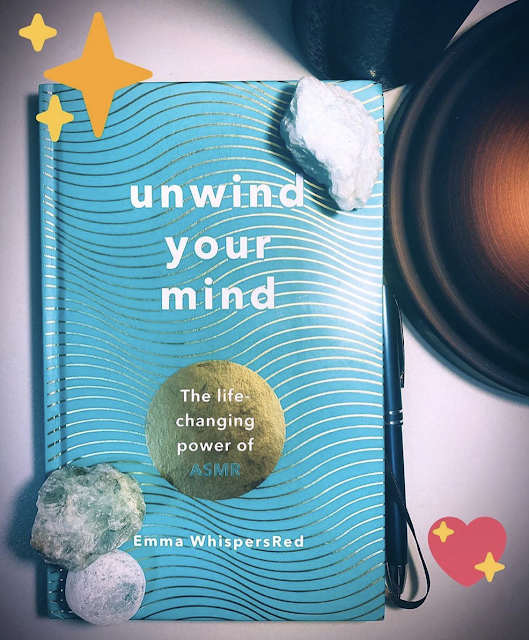"Unwind Your Mind: The Life-Changing Power of ASMR" by Emma WhispersRed (published 2019)
"I have touched on this already in the book; however, let me say it again: self-development, self-care and kindness is the number one most important job we have throughout our lives. However or whomever you are inside manifests itself in absolutely every aspect of your life, from how you think and how you behave to how you contribute to the world. I have heard it said so many times that living in service to others is the most fulfilling life there is and I wholeheartedly agree with this. But the only way to do that effectively and long term is to first nurture yourself to be the best you can." (p. 147)
Emma WhispersRed provides us with an art, or if you prefer, an artistic tool, for self-care and self-help. Autonomous Sensory Meridian Response, now commonly known as ASMR, is a relatively new phenomenon in dominant culture; people who have experienced the ASMR sensation in their childhoods or even before this generation didn't have a name and description for a tingly soothing feeling, known to start from the crown of the head and down the body, calming our nervous system. The world now has a scientific name for it, and the practice of ASMR has flooded social media, particularly YouTube, for the better.
Emma WhispersRed organizes her book into two parts: the first, More Than A Feeling which explains what it actually is and for what reasons it might be beneficial for people.
"...during my experience with PTSD (post traumatic stress disorder)... my mind was so busy re-living a past trauma and worrying about future events and current events that may or may not come. This caused a cycle of constant stress that just added to the issues. Through this there was no space to concentrate on how my body was feeling, so my mind and body were disconnected." (p. 71)
I do find Emma WhispersRed's words here illuminating - when anyone is under a severe amount of stress, anxiety, or any kind of consistent ailment - there is a tendency to become *out of body*; the body is neglected, abused, and disregarded. What ASMR can help with is re-sensitizing the body to sensation, a kind of physical therapy whose focus is on sound. Though Emma WhispersRed uses the word "healing" with trepidation, she does think there is a right time to use that particular word:
"Healing very simply means the process of regaining health. However, if we have the understanding that our health does not just include our physical body, it also means the process of gaining optimum health in body, mind and self or spirit. We can then understand that to heal is an ongoing process of growth, self-understanding, acceptance and self-love." (p. 74)
The way "Unwind Your Mind" is written is very much like how a healer would write. While Emma WhispersRed adds little bits of information about her personal life, she does not overwhelm the text with this; her main concern is to clearly explain what ASMR is, how it is currently used (making sure to point out that yes, it is capitalized upon by those who do not have the best motivations and we should watch out for this), and how it has proved to be helpful (the book includes a handful of personal stories from ASMR users around the world found at the very end).
It dawned on me, while reading, how holistic ASMR can be, even though it is primarily focused on auditory elements. Emma WhispersRed spends a couple pages discussing the concept of intuition, for example:
"Intuition - your 'inner knowing' - is having inner wisdom about something without the use of conscious thought... a very simple example of this would be if you meet someone and know 'deep down' that something is wrong and you want to ask. This is a natural intuitive response. However, conscious thought can then come in to tell us why we shouldn't say something. If we follow our mind here we are inhibited in this moment. By side-stepping our thoughts and telling the person anyway, we would be following our initial knowing or intuition." (p. 81)
The book explains concepts such as this but also provides a world of real, tactile, activities to do in order to hone in on your ASMR triggers. There are a host of different ways she provides, such as 'Earthing', or allowing your bare feet to touch solid ground (the soil, the grass) for a moment every day. If you can't do this, she provides visualization techniques to help you get there.
Part 2 is full of ways to begin living healthier by using ASMR techniques. Emma WhispersRed provides a day-night "schedule" which includes simple gestures to get you acquainted with how ASMR works. The brilliant thing is, she points out that you don't really need any supplies. You don't need to buy anything. You start with what you already have. I love that she includes a section on the ASMR Daydream; something I previously didn't quite understand.
"This exercise is an opportunity to have a moment to rest in a dreamy state - something we do too infrequently... daydreaming has been found to lower blood pressure and improve performance and working memory... we are going to focus on doing it intentionally to give our mind and brain a rest during the day. When we are daydreaming we usually arrive in a theta brainwave state..." (p. 159)
As you probably have gathered, "Unwind Your Mind" is full of practical information and useful guides to help you begin on an ASMR Journey. Once you begin searching, should you choose to do so, you'll find a variety of practitioners. As Emma WhispersRed suggests, choose one that you like and feel a connection to - there is no need to force a connection when one isn't felt. One of my favorite pieces of advice in this book is Emma WhispersRed's idea that ASMR should make you excited about getting up in the morning, excited about exploring life, your surroundings, the world. Even though this is extremely difficult depending on the situation in which you find yourself, ASMR doesn't ask you of anything except for you - you alone can begin to enjoy something, a sensory experience that may perhaps aid you in simply finding your breath.




Comments
Post a Comment